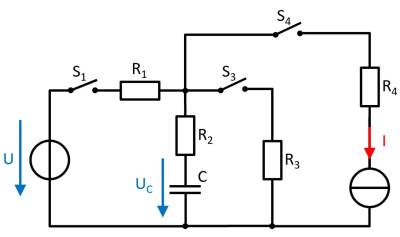Dies ist eine alte Version des Dokuments!
Excercise 7.2.6: temperature dependent resistor of a winding (exam task, ca. 11% of a 60 minute exam, WS2020)
The adjacent circuit with the following data is given:
- $U = 10 V$
- $I = 4 mA$
- $R_1 = 100 \Omega, R_2 = 80 \Omega, R_3 = 50 \Omega, R_4 = 10 \Omega$
- $C = 40 nF$
At first the capacitor is empty and all switches are open. The switsch S1 will be closed at t=0.
1. Determine the time constant $\tau$ for this charging process.
- What equivalent circuit can be found for the mentioned states of the switches?
- What parameter do you need to determine $\tau$?
- The charging current is flown through which component?
2. How high is the voltage at the capacitor $C$ when $t=10 µs$?
3. How high is the energy when the capacitor is fully charged?
4. Determine the new time constant when the capacitor is fully charged. The switch S1 will be opened whereas the switch S2 will be closed simultaneously.
5. When the capacitor is empty all switches will be opend. The switch S4 will be closed at $t = 1μs$.
How high is the voltage at the capacitor C?
- Through the current source there is a continuous flow of elctric charge into the capacitor.
- The resistors passed by the current on the way to the capacitor are irrelevant. They only increase the voltage of an ideal current source to guarantee the current.
